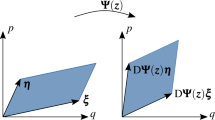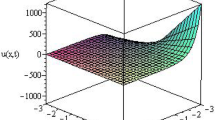Abstract
This work illustrates how one could apply Lie point symmetries for finding the analytical solution to first-order mechanical systems. Although the classical Lie method constitutes a powerful tool for solving differential equations, an obstacle appears in the case of systems of first-order equations because they admit an infinite number of symmetries, and it is not possible to compute them by following a systematic procedure. To overcome this difficulty, we follow the idea exposed in Nucci (J. Math. Phys. 37: 1772–1775, 1996), Nucci (Electr. J. Diff. Eqn. 12: 87–101, 2005), Nucci (J. Math. Phys. 42: 746, 2001) consisting of transforming the original system to an equivalent system in which one of the equations is of second–order. The presented approach is applied to Hathaway’s circular pursuit problem, leading to the analytical solution of the system expressed in terms of the general solution to an Abel equation.

Similar content being viewed by others
References
Allen, L.: Evolution of flight simulation. In: Flight Simulation and Technologies, pp. 1–1. American Institute of Aeronautics and Astronautics (1993)
Anco, S., Bluman, G.: Symmetry and Integration Methods for Differential Equations. Springer, New York (2002)
Barton, J.C., Eliezer, C.J.: On pursuit curves. J. Austr. Math. Soc. Ser. B Appl. Math. 41(3), 358–371 (2000)
Basquerotto, C.H.C.C., Righetto, E., Silva, S.D.: Applications of the Lie symmetries to complete solution of a bead on a rotating wire hoop. J. Br. Soc. Mech. Sci. Eng. 40(2), 48 (2018)
Basquerotto, C.H.C.C., Ruiz, A., Righetto, E., da Silva, S.: Moving frames for Lie symmetries reduction of nonholonomic systems. Acta Mech. 230(8), 2963–2978 (2019)
Blumman, G.W., Kumei, S.: Symmetries and Differential Equations. Applied Mathematical Sciences, vol. 81. Springer, New York (1989)
Bradley, H.C., Harding, A.M., Hathaway, A.S., Weaver, W., Corey, S.A., Gronwall, T.H., Mills, C.N., Moritz, R.E.: Problems for solution. Am. Math. Mon. 27(1), 31 (1920)
Čenek, E.: Chases and escapes by Paul. J. Nahin. ACM SIGACT News 40(3), 48 (2009)
Chashchina, O.I., Silagadze, Z.K.: The dog-and-rabbit chase problem as an exercise in introductory kinematics. Latin-Am. J. Phys. Educ. pp. 539–543 (2009)
Davis, H.: Introduction to Nonlinear Differential and Integral Equations. Dover Publications, New York (1962)
Dichter, M.: Student Solutions Manual for Nonlinear Dynamics and Chaos, vol. 2. Westview Press, Boulder (2016)
Dopico, D., González, F., Luaces, A., Saura, M., García-Vallejo, D.: Direct sensitivity analysis of multibody systems with holonomic and nonholonomic constraints via an index-3 augmented Lagrangian formulation with projections. Nonlinear Dyn. 93(4), 2039–2056 (2018)
Hoskins, J., Bluman, G.: Higher order symmetries and integrating factors for ordinary differential equations. J. Math. Anal. Appl. 435(1), 133–161 (2016)
Hydon, P.E.: Symmetry Methods for Differential Equations. Cambridge University Press, Cambridge (2005)
Ibragimov, N.H.: Practical Course in Differential Equations And Mathematical Modelling, A: Classical and New Methods. Nonlinear Mathematical Models Symmetry and Invariance Principles. World Scientific Publishing Co Pte Ltd, Singapore (2009)
Li, J., Wu, H., Mei, F.: Dynamic analysis for the hyperchaotic system with nonholonomic constraints. Nonlinear Dyn. 90(4), 2557–2569 (2017)
Mungan, C.E.: A classic chase problem solved from a physics perspective. Eur. J. Phys. 26(6), 985–990 (2005)
Nahin, P.J.: Chases and Escapes. Princeton University Press, New Jersey (2012)
Nucci, M.C.: The complete kepler group can be derived by lie group analysis. J. Math. Phys. 37(4), 1772–1775 (1996)
Nucci, M.C.: Using Lie symmetries in epidemiology. Electr. J. Diff. Eqn. 12, 87–101 (2005)
Nucci, M.C., Leach, P.G.L.: The harmony in the kepler and related problems. J. Math. Phys. 42(2), 746 (2001)
Olver, P.J.: Applications of Lie Groups to Differential Equations. Springer, New York (1986)
Olver, P.J.: Equivalence, Invariants and Symmetry. Cambridge University Press, Cambridge (2008)
Rolfe, J.M., Bolton, M.: Flight simulation in the royal air force in the second world war. Aeronaut. J. 92(918), 315–327 (1988)
Small, J.S.: Engineering, technology and design: the post-second world war development of electronic analogue computers. History Technol. 11(1), 33–48 (1994)
Strogatz, S.: Nonlinear Dynamics and Chaos: With Applications to Physics, Biology, Chemistry, and Engineering. Studies in Nonlinearity. Westview Press, Boulder (2014)
Torrisi, V., Nucci, M.C.: Application of Lie group analysis to a mathematical model which describes HIV transmission (2001)
Zaitsev, V.F., Polyanin, A.D.: Handbook of Exact Solutions for Ordinary Differential Equations. Chapman and Hall/CRC, Boca Raton (2002)
Acknowledgements
C. H. C. C. Basquerotto is grateful for the financial support provided by the Brazilian National Council for Scientific and Technological Development (CNPq - Brazil) in grant number 426050/2018-5. A. Ruiz thanks the financial support from FEDER–Ministerio de Ciencia, Innovación y Universidades–Agencia Estatal de Investigación via the project PGC2018-101514-B-I00 and from Junta de Andalucía to the research group FQM–377. S. da Silva is grateful for the financial support provided by the Brazilian National Council for Scientific and Technological Development (CNPq - Brazil) in the grant numbers 404463/2016-9 and 306526/2019-0.
Author information
Authors and Affiliations
Corresponding author
Ethics declarations
Conflict of interests
The authors declare that there is no conflict of interest regarding the publication of this article.
Additional information
Publisher's Note
Springer Nature remains neutral with regard to jurisdictional claims in published maps and institutional affiliations.
Rights and permissions
About this article
Cite this article
Basquerotto, C.H.C.C., Ruiz, A., da Silva, S. et al. An illustrative application of the Lie symmetries in the context of first-order mechanical systems: Hathaway’s circular pursuit problem. Acta Mech 233, 1031–1039 (2022). https://doi.org/10.1007/s00707-022-03150-5
Received:
Revised:
Accepted:
Published:
Issue Date:
DOI: https://doi.org/10.1007/s00707-022-03150-5




